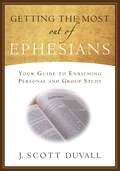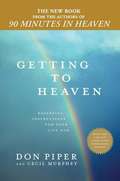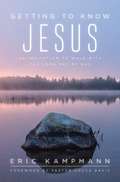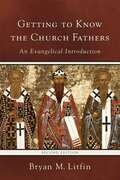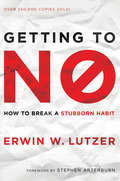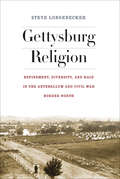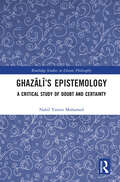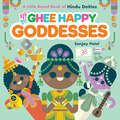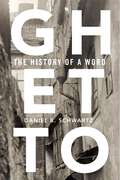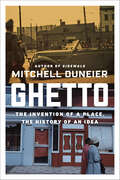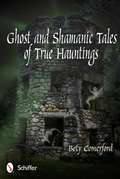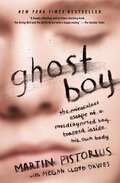- Table View
- List View
Getting a Grip
by Bill Hybels Kevin HarneyHow to gain traction when you’re out of control. If you drive anywhere in the snow belt, you probably know the feeling: rear wheels fishtailing, steering useless, brakes ineffective—you’re out of control. The good news is, life doesn’t have to be like a car on ice. Bill Hybels offers biblical insights and practical steps to securing a Christ-centered life that will get you where you want to go. Getting a Grip guides you toward wise choices and disciplined action in five vital areas of your life: your time, your health, your finances, your spiritual life, and your relationships. As you learn what the Bible has to say about each of these, you’ll discover how able and eager Jesus is to help you obtain solid traction on the road of life. Interactions—a powerful and challenging tool for building deep relationships between you and your group members, and you and God. Interactions is far more than another group Bible study. It's a cutting-edge series designed to help small group participants develop into fully devoted followers of Christ.
Getting into the Vortex: Guided Meditations Audio Download And User Guide
by Esther Jerry HicksLiving a better-feeling life really comes down to one thing only: coming into alignment with the Energy of our Source. Abraham reminds us that we are truly Source Energy focused into our physical bodies, and that a conscious Connection to that Broader Non-Physical part of us is necessary if we are to be the joyful Beings that we were born to be. Abraham calls that wonderful alignment Getting into the Vortex.
Getting the Church On Target
by Lloyd PerryTools and advice for assessing your church&“These are dangerous days for the organized church…. It is time to be alert to what is taking place and make some changes.&” So writes Lloyd Perry in his introduction to Getting the Church on Target. Dr. Perry then goes on to outline ways the local church can be revitalized. His concerns are reflected in chapter titles such as:Having God&’s Man in God&’s Place for MinistryClarifying Purposes, Goals, and ObjectivesSystematizing Church Management Training for LeadershipMobilizing the LaityManaging Conflict Creatively Establishing Small Groups for Ministry Expanding the Outreach of the Church Updating Our WorshipThe final chapter includes five sample self-evaluation surveys to help a church assess its problems and progress.
Getting the Church On Target
by Lloyd PerryTools and advice for assessing your church&“These are dangerous days for the organized church…. It is time to be alert to what is taking place and make some changes.&” So writes Lloyd Perry in his introduction to Getting the Church on Target. Dr. Perry then goes on to outline ways the local church can be revitalized. His concerns are reflected in chapter titles such as:Having God&’s Man in God&’s Place for MinistryClarifying Purposes, Goals, and ObjectivesSystematizing Church Management Training for LeadershipMobilizing the LaityManaging Conflict Creatively Establishing Small Groups for Ministry Expanding the Outreach of the Church Updating Our WorshipThe final chapter includes five sample self-evaluation surveys to help a church assess its problems and progress.
Getting the Most Out of Ephesians: Your Guide for Enriching Personal and Group Study
by J. Scott DuvallAn interactive workbook containing a good balance of insightful exposition and well--designed questions for personal and group application. The book also offers illustrations to help the reader understand the cultural background of Ephesians and interesting asides and quotes. Ideal for devotions as well as group or personal study.
Getting the Reformation Wrong: Correcting Some Misunderstandings
by James R. Payton Jr.Institutes of the Christian Religion.Getting the Reformation Wrong:places the Reformation in the context of medieval and Renaissance reform effortsanalyzes conflicts among the Reformerssola fidesola Scripturaexamines how the Anabaptist movement fits in with the magisterial Reformationcritiques the post-Reformational move to Protestant Scholasticismexplores how the fresh perspective on the Reformation could make a difference in today's churches
Getting to Heaven
by Cecil Murphey Don PiperWatch a video From the author of the multimillion-selling bestselling, 90 Minutes in Heaven, spiritual instructions for living and preparing for eternal life. Since publishing his inspirational bestseller in 2004, Don Piper has traveled the world spreading his message of faith--certain faith--in the promise of Heaven. In Heaven is Real, Piper shared how life's trials can be turned into spiritual lessons, when we are open to the certainty of God's grace and love. Now, in his first new book in four years, Piper draws on his own firsthand experiences with the joys of Heaven--as well as the lessons found in the Gospel--to offer a set of "departing instructions," helping readers face the inevitable battles ahead, prepare for eternal life, and, starting today, live a happy, fulfilling, purposeful life on Earth while preparing for the glories of Heaven.
Getting to Know Jesus: An Invitation to Walk with the Lord Day by Day
by Eric Kampmann**Winner of the 2017 CSPA Book of the Year Award in Devotionals** Getting to Know Jesus is the perfect devotional for the person who knows some but wants to know much more about the life and ministry of Jesus Christ. This award winning book is designed follow the life of Jesus Christ chronologically based on the Gospels of Matthew, Mark, Luke, and John. The origins of this book were a series of podcasts that author Eric Kampmann and Dr. Chuck Davis, Senior Pastor at Stanwich Church, recorded over the course of one full year. For this book, Kampmann used the content of the podcasts to build a commentary on the passage that provides a deeper look into the accounts of Jesus' life, ministry, crucifixion, and resurrection. In addition to the book, Kampmann has provided an index that lists 31 bible or individual studies. The studies include an in depth look at the Sermon on the Mount, the Parable of the Prodigal Son, Raising Lazarus, the Seven Words of the Cross, the High Priestly Prayer, and much more.
Getting to Know the Church Fathers: An Evangelical Introduction
by Bryan M. LitfinThis concise introduction to the church fathers connects evangelical students and readers to twelve key figures from the early church. Bryan Litfin engages readers with actual people, not just abstract doctrines or impersonal events, to help them understand the fathers as spiritual ancestors in the faith. <p><p>The first edition has been well received and widely used. This updated and revised edition adds chapters on Ephrem of Syria and Patrick of Ireland. The book requires no previous knowledge of the patristic period and includes original, easy-to-read translations that give a brief taste of each writer's thought.
Getting to No
by Erwin W. LutzerEveryone is familiar with the cycle: We decide to break a bad habit once and for all. We may even experience some short-term success. Yet almost inevitably, we fall back into that undesirable behavior and the frustrating process starts all over again. The experience can leave us feeling powerless to make changes in our lives.Popular author and pastor Erwin Lutzer believes it is possible to break the cycle of addictive behavior. Filled with biblical insight, Getting to No: How to Break a Stubborn Habit takes an honest look at the temptations lying beneath the surface of every bad habit. Lutzer examines tough issues--such as why temptation exists, what purpose it serves in our lives, and what happens when we fail again--and provides practical tools that will help you find freedom from bad habits for good.
Getting to know God: Learn about him through a personal and amazing experience
by Andrés RamírezLook for answers based on personal experiences and real events to questions such as : Does God Exist? How will the enemy attack you? How can I listen to God? How can I change my life? How to start having a close relationship with God? Learn through this book how to change your life regardless of the circumstances in which you find yourself or how you can change the lives of other people. This book was written especially for those who do not know about God or do not believe in Him. Recommended for anyone who wants to learn in depth how to have an intimate relationship with God, Jesus and the Holy Spirit.
Gettysburg Religion: Refinement, Diversity, and Race in the Antebellum and Civil War Border North (The North's Civil War)
by Steve LongeneckerIn the borderland between freedom and slavery, Gettysburg remains among the most legendary Civil War landmarks. A century and a half after the great battle, Cemetery Hill, the Seminary and its ridge, and the Peach Orchard remain powerful memories for their embodiment of the small-town North and their ability to touch themes vital to nineteenth-century religion. During this period, three patterns became particularly prominent: refinement, diversity, and war. In Gettysburg Religion, author Steve Longenecker explores the religious history of antebellum and Civil War–era Gettysburg, shedding light on the remarkable diversity of American religion and the intricate ways it interacted with the broader culture. Longenecker argues that Gettysburg religion revealed much about larger American society and about how trends in the Border North mirrored national developments. In many ways, Gettysburg and its surrounding Border North religion belonged to the future and signaled a coming pattern for modern America.
Gewaltfreiheit zwischen Anspruch und Realität: Grundsatzfragen • Band 6 (Gerechter Frieden)
by Angelika Dörfler-Dierken Hendrik StoppelDas Bekenntnis zum Weg der Gewaltfreiheit nimmt in der Kundgebung der EKD-Synode 2019 „Kirche auf dem Weg der Gerechtigkeit und des Friedens“ den ersten Rang unter den Aussagen zum Thema Frieden ein. Aber der kirchliche Diskurs kennt auch eine zweite Option, die unter bestimmten Bedingungen notwendig werden kann: den Gebrauch von „rechtserhaltender Gewalt“, der gerade den Frieden herstellen oder wahren soll. In diesem Spannungsfeld stehen die kirchliche Militärseelsorge und Soldat*innen mit kirchlicher Bindung. Die verschiedenen Voten und deren Grundlegungen und Konsequenzen werden in diesem Band diskutiert.
Ghalib: Selected Poems and Letters (Translations from the Asian Classics #Vol. No. 7)
by Mirza Asadullah GhalibThis selection of poetry and prose by Ghalib provides an accessible and wide-ranging introduction to the preeminent Urdu poet of the nineteenth century. Ghalib's poems, especially his ghazals, remain beloved throughout South Asia for their arresting intelligence and lively wit. His letters—informal, humorous, and deeply personal—reveal the vigor of his prose style and the warmth of his friendships. These careful translations allow readers with little or no knowledge of Urdu to appreciate the wide range of Ghalib's poetry, from his gift for extreme simplicity to his taste for unresolvable complexities of structure.Beginning with a critical introduction for nonspecialists and specialists alike, Frances Pritchett and Owen Cornwall present a selection of Ghalib's works, carefully annotating details of poetic form. Their translation maintains line-for-line accuracy and thereby preserves complex poetic devices that play upon the tension between the two lines of each verse. The book includes whole ghazals, selected individual verses from other ghazals, poems in other genres, and letters. The book also includes a glossary, the Urdu text of the original poetry, and an appendix containing Ghalib's comments on his own verses.
Ghazali and the Poetics of Imagination
by Ebrahim MoosaAbu Hamid al-Ghazali, a Muslim jurist-theologian and polymath who lived from the mid-eleventh to the early twelfth century in present-day Iran, is a figure equivalent in stature to Maimonides in Judaism and Thomas Aquinas in Christianity. He is best known for his work in philosophy, ethics, law, and mysticism. In an engaged re-reading of the ideas of this preeminent Muslim thinker, Ebrahim Moosa argues that Ghazali's work has lasting relevance today as a model for a critical encounter with the Muslim intellectual tradition in a modern and postmodern context. Moosa employs the theme of the threshold, or dihliz, the space from which Ghazali himself engaged the different currents of thought in his day, and proposes that contemporary Muslims who wish to place their own traditions in conversation with modern traditions consider the same vantage point. Moosa argues that by incorporating elements of Islamic theology, neoplatonic mysticism, and Aristotelian philosophy, Ghazali's work epitomizes the idea that the answers to life's complex realities do not reside in a single culture or intellectual tradition. Ghazali's emphasis on poiesis--creativity, imagination, and freedom of thought--provides a sorely needed model for a cosmopolitan intellectual renewal among Muslims, Moosa argues. Such a creative and critical inheritance, he concludes, ought to be heeded by those who seek to cultivate Muslim intellectual traditions in today's tumultuous world.
Ghazali's Politics in Context (Culture and Civilization in the Middle East)
by Yazeed SaidImam Abü Hamid al-Ghazalı is perhaps the most celebrated Muslim theologian of medieval Islam yet little attention has been paid to his personal theology. This book sets out to investigate the relationship between law and politics in the writings of Ghazalı and aims to establish the extent to which this relationship explains Ghazalı’s political theology. Articles concerned with Ghazalı’s political thought have invariably paid little attention to his theology and his thinking about God, neglecting to ask what role these have contributed to his definition of politics and political ethics. Here, the question of Ghazalı’s politics takes into account his thinking on God, knowledge, law, and the Koran, in addition to political systems and ethics. Yazeed Said puts forward the convincing argument that if Ghazalı’s legal and political epistemology provide a polemic analogous to his writings on philosophy, for which he is more famed, they would reveal to us a manifesto for an alternative order, concerned with a coherent definition of the community, or Ummah. This book will be an invaluable resource for students and scholars of the Middle East, political theology and Islamic studies.
Ghazali: The Revival of Islam (Makers of the Muslim World #759)
by Eric OrmsbyThis fascinating work profiles Abu Hamid al-Ghazali (1058-1111), the foremost Islamic scholar and mystic of the medieval period. Attracting the patronage of the vizier Nizam al-Mulk early in his career, he was appointed head of the Nizamiyyah College at Baghdad, and attracted audiences from across the Islamic world, who sought his teachings on Islamic philosophy and jurisprudence. Eventually renouncing his position due to a spiritual crisis, he went into self-imposed exile, during which he wrote the Sufi masterpiece, Revival of the Sciences of Religion. Concise and lucid, this is a perfect introduction to the great man's life and work.
Ghazālī’s Epistemology: A Critical Study of Doubt and Certainty (Routledge Studies in Islamic Philosophy)
by Nabil Yasien MohamedFocusing on Abū Ḥāmid al-Ghazālī (d. 1111) – one of the foremost scholars and authorities in the Muslim world who is central to the Islamic intellectual tradition – this book embarks on a study of doubt (shakk) and certainty (yaqīn) in his epistemology. The book looks at Ghazālī’s attitude to philosophical demonstration and Sufism as a means to certainty. In early scholarship surrounding Ghazālī, he has often been blamed as the one who single-handedly offered the death-blow to philosophy in the Muslim world. In much of contemporary scholarship, Ghazālī is understood to prefer philosophy as the ultimate means to certainty, granting Sufism a secondary status. Hence, much of previous scholarship has either focused on Ghazālī as a Sufi or as a philosopher; this book takes a parallel approach, and acknowledges each discipline in its right place. It analyses Ghazālī’s approach to acquiring certainty, his methodological scepticism, his foundationalism, his attitude to authoritative instruction (taʿlim), and the place of philosophical demonstration and Sufism in his epistemology. Offering a systematic and comprehensive approach to Ghazālī’s epistemology, this book is a valuable resource for scholars of Islamic philosophy and Sufism in particular, and for educated readers of Islamic studies in general.
Ghee Happy Goddesses: A Little Board Book of Hindu Deities
by Sanjay PatelA vibrantly illustrated board book inspired by Sanjay Patel's animated Netflix show, Ghee Happy, featuring Hindu deities as toddlers!In the world of Sanjay Patel, creator of the Oscar-nominated Pixar short Sanjay's Super Team, the bold, bright colors of India leap off the page and screen. In his new children's book, drawn from Indian mythology, you'll meet the many faces (and arms) of the mighty Hindu goddesses!With dynamic illustrations and colorful tabs for each goddess, this eye-catching board book introduces the youngest readers to Hindu goddesses Durga, Saraswati, Lakshmi, Ganga, Parvati, and Kali. Get them together, and anything is possible.INSPIRED BY THE NETFLIX SHOW: The same deities in this book are featured in Sanjay Patel's Netflix show, which stars the Hindu gods and goddesses as tiny toddlers in preschool!NOTABLE CREATOR: Patel produced a short based on his life, Sanjay's Super Team, with Pixar, and Netflix's Ghee Happy series. His brand, Ghee Happy, has reached an eager audience with books, museum exhibitions, and merchandise. He is also the author of the popular picture book Ramayana, a twenty-first century retelling of a classic 2500-year-old story.VIBRANT & GIFTABLE: Ghee Happy Goddesses and companion volume Ghee Happy Gods are perfect for baby showers and first birthdays, as families welcome their own little goddesses and gods to the world and introduce them to the Hindu deities.DIVERSE CHILDRENS BOOKS: Featuring lovable characters and a light narrative, this book provides a fresh and accessible way for families who practice Hinduism to see themselves and celebrate. It's also a wonderful resource for Hindu parents, caregivers, and educators to introduce young readers to their own religious beliefs and promote religious literacy for all.PERFECT FOR LITTLE HANDS: With sturdy tabs, rounded corners, and simple profiles, this book provides a fun approach to learning and identifying each Hindu deity.Perfect for:Parents and grandparents looking for entertaining board books for toddlersReaders who love Hindu goddess mythology and adventure talesEducational material for classroom or homeschool curriculumAnyone looking for children's literature featuring Indian mythologyGift giving for Diwali, baby shower, birthday, or any special occasionFans of Ganesha's Sweet Tooth, Pixar's Sanjay's Super Team, and Netflix's Ghee Happy
Ghee Happy Gods: A Little Board Book of Hindu Deities
by Sanjay PatelA vibrantly illustrated board book inspired by Sanjay Patel's animated Netflix show, Ghee Happy, featuring Hindu deities as toddlers!In the world of Sanjay Patel, creator of the Oscar-nominated Pixar short Sanjay's Super Team, the bold, bright colors of India leap off the page and screen. In his new children's book, drawn from Indian mythology, you'll meet the many faces (and arms) of the mighty Hindu gods!With dynamic illustrations and colorful tabs for each god, this eye-catching board book introduces the youngest readers to Hindu gods Ganesha, Shiva, Brahma, Vishnu, Rama, and Krishna. Get them together, and anything is possible.INSPIRED BY THE NETFLIX SHOW: The same deities in this book are featured in Sanjay Patel's Netflix show, which stars the Hindu gods and goddesses as tiny toddlers in preschool!NOTABLE CREATOR: Patel produced a short based on his life, Sanjay's Super Team, with Pixar, and Netflix's Ghee Happy series. His brand, Ghee Happy, has reached an eager audience with books, museum exhibitions, and merchandise. He is also the author of the popular picture book Ramayana, a twenty-first century retelling of a classic 2500-year-old story.VIBRANT & GIFTABLE: Ghee Happy Gods and companion volume Ghee Happy Goddesses are perfect for baby showers and first birthdays, as families welcome their own little gods and goddesses to the world and introduce them to the Hindu deities.DIVERSE CHILDRENS BOOKS: Featuring lovable characters and a light narrative, this book provides a fresh and accessible way for families who practice Hinduism to see themselves and celebrate. It's also a wonderful resource for Hindu parents, caregivers, and educators to introduce young readers to their own religious beliefs and promote religious literacy for all.PERFECT FOR LITTLE HANDS: With sturdy tabs, rounded corners, and simple profiles, this book provides a fun approach to learning and identifying each Hindu deity.Perfect for:Parents and grandparents looking for entertaining board books for toddlersReaders who love Hindu mythology and adventure talesEducational material for classroom or homeschool curriculumAnyone looking for children's literature featuring Indian mythologyGift giving for Diwali, baby shower, birthday, or any special occasionFans of Ganesha's Sweet Tooth, Pixar's Sanjay's Super Team, and Netflix's Ghee Happy
Ghenko: The Mongol Invasion of Japan, 1274-81
by Nakaba Yamada“A ferocious conflict between Mongol and Samurai.The Japanese word 'Ghenko' is the term employed for the Mongol invasion of Japan. The event was an immensely significant one for the Japanese and it remained so for centuries because, in part, the defeat of the invaders was attributed to divine intervention. There can be little doubt that Japan's salvation had much to do with the fact that they are an island race and in that they have much in common with other islanders, Great Britain among them, who on more than one occasion might claim the sea as their principal and most powerful ally. Indeed, the author of this book draws parallels with Britain and the Spanish Armada. The Mongols had rapidly risen to power during the 13th century and had created an unstoppable empire that spread over huge areas of land from the Yellow Sea of Asia to the Danube in Europe. Although massively stronger than the Japanese, the Mongols attacked the Japanese islands, attempting domination by invasion and yet were repulsed with finality. To modern students of military history the contents of this book has a compelling allure, since there can be no doubt that in the Mongol warrior and the Japanese Samurai there resided a martial spirit and expertise which, perhaps inevitably, could not both exist in the same sphere, but which in collision could not fail to instigate conflict of the most singular kind. This account of the clash between the ultimate warriors of their day analyses this time of warfare in superb detail. An essential addition to the library of anyone interested in the warfare of the East.”-Print ed.
Ghetto: The History of a Word
by Daniel B. SchwartzFew words are as ideologically charged as “ghetto,” a term that has described legally segregated Jewish quarters, dense immigrant enclaves, Nazi holding pens, and black neighborhoods in the United States. Daniel B. Schwartz reveals how the history of ghettos is tied up with struggle and argument over the slippery meaning of a word.
Ghetto: The Invention of a Place, the History of an Idea
by Mitchell DuneierA New York Times Notable Book of 2016 Winner of the Zócalo Public Square Book PrizeOn March 29, 1516, the city council of Venice issued a decree forcing Jews to live in il geto—a closed quarter named for the copper foundry that once occupied the area. The term stuck.In this sweeping and original account, Mitchell Duneier traces the idea of the ghetto from its beginnings in the sixteenth century and its revival by the Nazis to the present. As Duneier shows, we cannot comprehend the entanglements of race, poverty, and place in America today without recalling the ghettos of Europe, as well as earlier efforts to understand the problems of the American city.Ghetto is the story of the scholars and activists who tried to achieve that understanding. As Duneier shows, their efforts to wrestle with race and poverty cannot be divorced from their individual biographies, which often included direct encounters with prejudice and discrimination in the academy and elsewhere. Using new and forgotten sources, Duneier introduces us to Horace Cayton and St. Clair Drake, graduate students whose conception of the South Side of Chicago established a new paradigm for thinking about Northern racism and poverty in the 1940s. We learn how the psychologist Kenneth Clark subsequently linked Harlem’s slum conditions with the persistence of black powerlessness, and we follow the controversy over Daniel Patrick Moynihan’s report on the black family. We see how the sociologist William Julius Wilson redefined the debate about urban America as middle-class African Americans increasingly escaped the ghetto and the country retreated from racially specific remedies. And we trace the education reformer Geoffrey Canada’s efforts to transform the lives of inner-city children with ambitious interventions, even as other reformers sought to help families escape their neighborhoods altogether.Duneier offers a clear-eyed assessment of the thinkers and doers who have shaped American ideas about urban poverty—and the ghetto. The result is a valuable new estimation of an age-old concept.
Ghost And Shamanic Tales Of True Hauntings
by Bety ComerfordJoin the Spirit Light Network, a paranormal investigative team of shamans and energy healers dedicated to helping spirits cross to the Other Side. Experience 12 interesting and frightening ghost hunts to find out why ghosts exist and wander the earth, how some people are more likely to be haunted than others, and what to do if you become a haunted person. Read about a boy haunted by British soldiers, a curse on a colonial farmhouse, a spirit who won't leave until her head is returned, and more. Along the way, you'll learn step-by-step instructions for varied energy techniques to ensure that you won't succumb to energies from both sides of the Veil, including how to ground energy, cut cords that may be draining you, balance and raise your vibration, and more. Discover why the Spirit Light Network is known as the group that "treads where others dread. "
Ghost Boy: The Miraculous Escape of a Misdiagnosed Boy Trapped Inside His Own Body
by Martin PistoriusThey all thought he was gone. But he was alive and trapped inside his own body for ten years. In January 1988 Martin Pistorius, aged twelve, fell inexplicably sick. First he lost his voice and stopped eating. Then he slept constantly and shunned human contact. Doctors were mystified. Within eighteen months he was mute and wheelchair-bound. Martin's parents were told an unknown degenerative disease left him with the mind of a baby and less than two years to live. Martin was moved to care centers for severely disabled children. The stress and heartache shook his parentsÆ marriage and their family to the core. Their boy was gone. Or so they thought. Ghost Boy is the heart-wrenching story of one boyÆs return to life through the power of love and faith. In these pages, readers see a parentÆs resilience, the consequences of misdiagnosis, abuse at the hands of cruel caretakers, and the unthinkable duration of MartinÆs mental alertness betrayed by his lifeless body. We also see a life reclaimedùa business created, a new love kindledùall from a wheelchair. Martin's emergence from his own darkness invites us to celebrate our own lives and fight for a better life for others.



